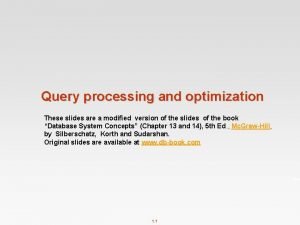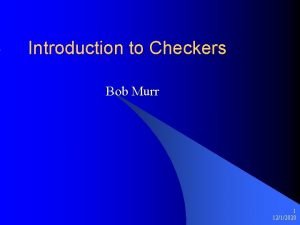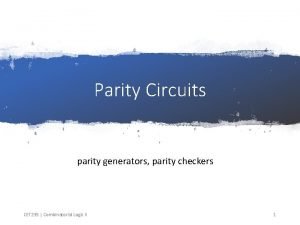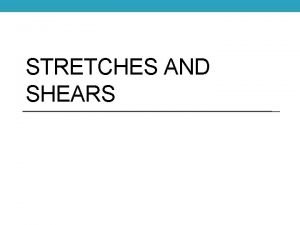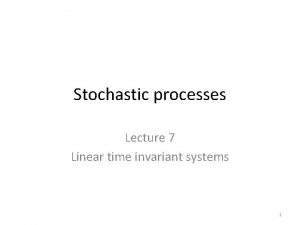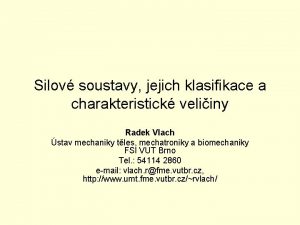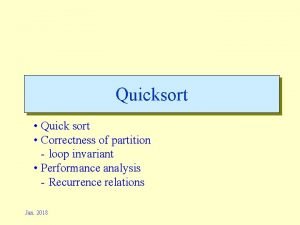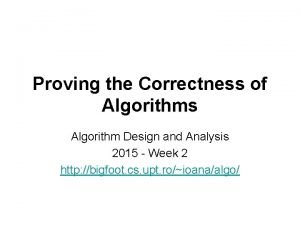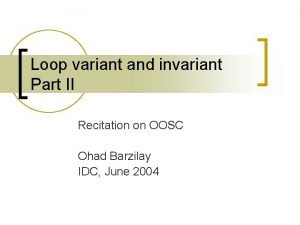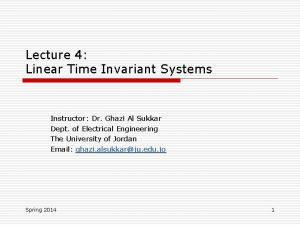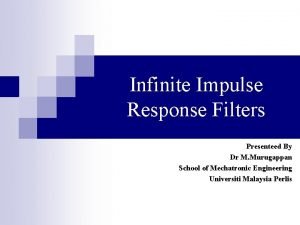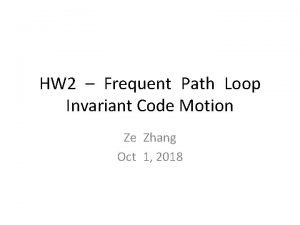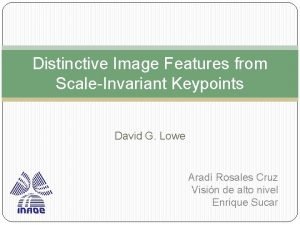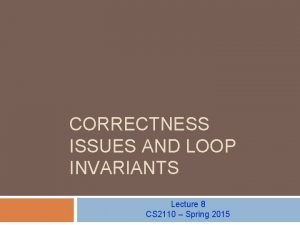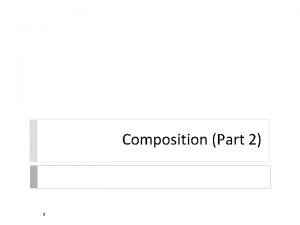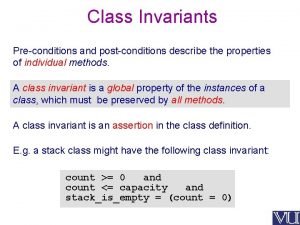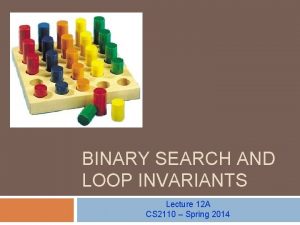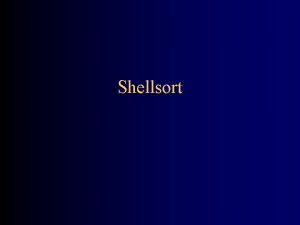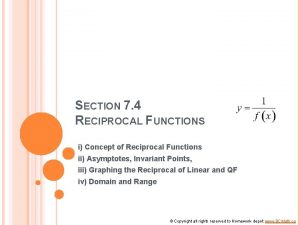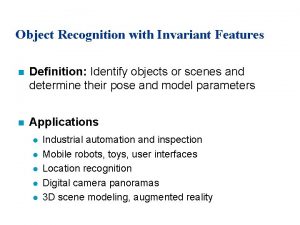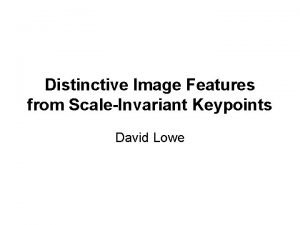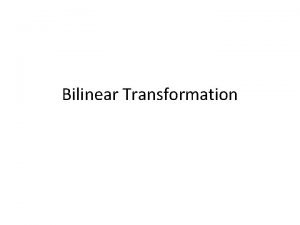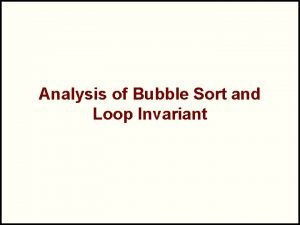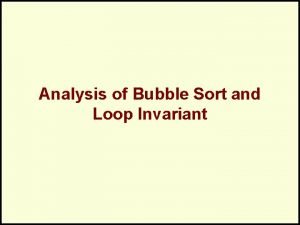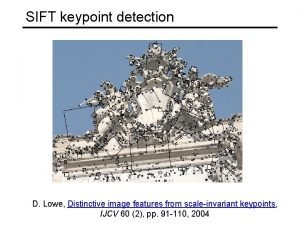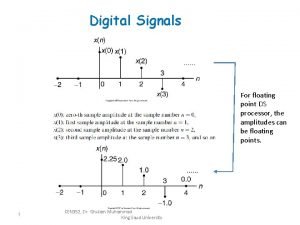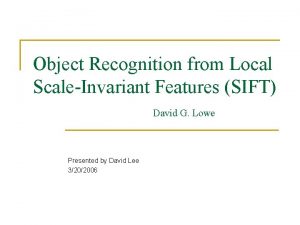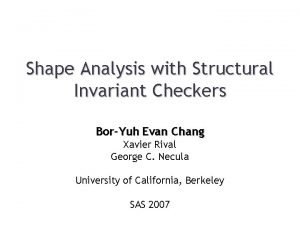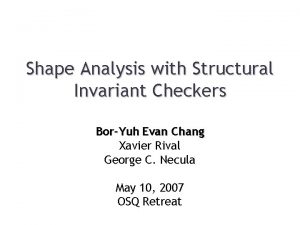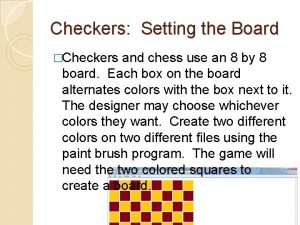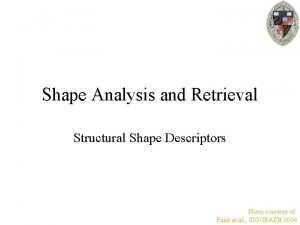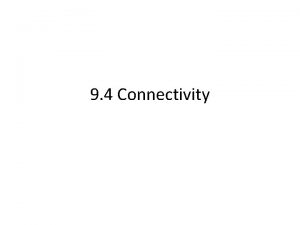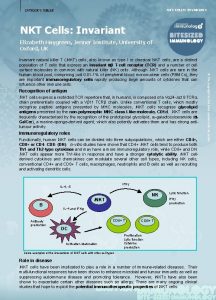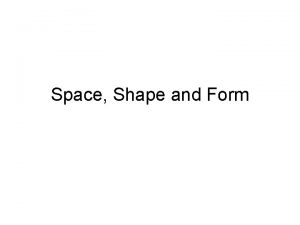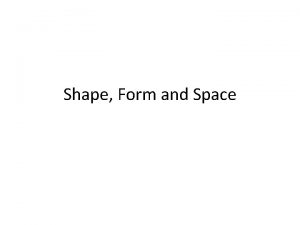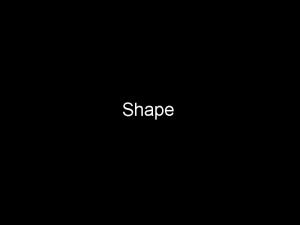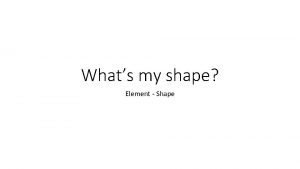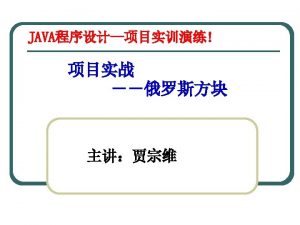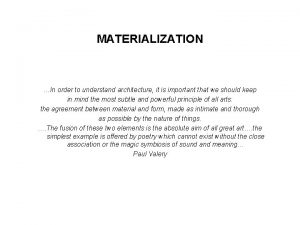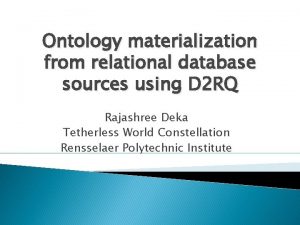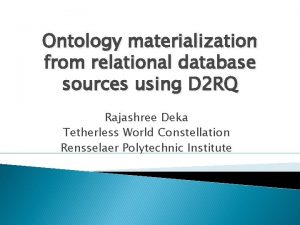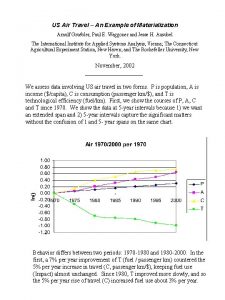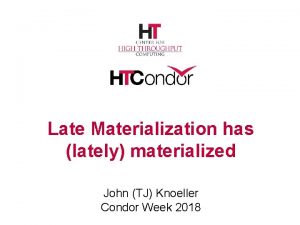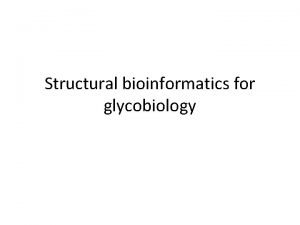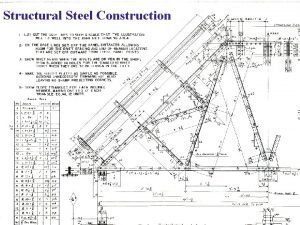Materialization in Shape Analysis with Structural Invariant Checkers







































- Slides: 39

Materialization in Shape Analysis with Structural Invariant Checkers Bor-Yuh Evan Chang Xavier Rival George C. Necula University of California, Berkeley August 27, 2007 ITU Copenhagen

What’s shape analysis? What’s special? Shape analysis tracks memory manipulation in a flow-sensitive manner. • Memory manipulation – Particularly important in systems code (in C) • Flow-sensitive – Many important properties • E. g. , Is an object freed? Is a file open? – Heap abstracted differently at different points • E. g. , Not based on allocation site 2

Example: Typestate with shape analysis Concrete Example Abstraction l l “red list” cur = l; program-specific predicate while (cur != null) { assert(cur is red); flow-sensitive heap abstraction make_purple(cur); make_purple(¢) could be l cur = cur!next; • • lock(¢) “purple “red l free(¢) list segment” list” open(¢) cur … } 3

Shape analysis is not yet practical Usability: Usability Choosing the heap abstraction difficult “red list” Space Invader [Distefano et al. ] “red list” Built-in high-level predicates - Hard to extend + No additional user effort Parametric in low-level, analyzer-oriented predicates red(n) Æ n 2 reach(l) TVLA [Sagiv et al. ] + Very general and expressive - Hard for non-expert Parametric in high-level, developer-oriented predicates “red list” Our Proposal + Extensible + Easier for developers 4

Shape analysis is not yet practical Scalability: Scalability Finding right level of abstraction difficult Over-reliance on disjunction for precision “purple “red list segment” list” l cur developer emp shape analyzer l cur Ç Ç l cur Ç l l, cur Ç Ç Ç l, cur l cur 5

Hypothesis The developer can describe the memory in a compact manner at an abstraction level sufficient for the properties of interest (at least informally). • Good abstraction is program-specific l “purple list segment” “red list” abstraction cur developer ? shape analyzer 6

Observation Checking code expresses a shape invariant and an intended usage pattern. bool redlist(List* l) { if (l == null) return true; else return l!color == red && redlist(l!next); l l } 7

Proposal An automated shape analysis with a memory abstraction parameterized by invariant checkers bool redlist(List* l) { if (l == null) return true; else return l!color == red && redlist(l!next); } checkers shape analyzer • Extensible – Abstraction based on the developer-supplied checkers • Targeted for Usability – Global data structure specification, local invariant inference • Targeted for Scalability – Based on the hypothesis 8

Shape analysis is an abstract interpretation on memory states with … • Materialization (partial concretization) l, cur • “red list” l, cur To perform strong updates “red list” l, cur “red list” l cur • And widening for termination “red list” l cur l “purple “red list segment” list” cur 9

Outline • Memory abstraction – Restrictions on checkers – Challenge: Intermediate invariants • Materialization by forward unfolding – Where and how – Challenge: Unfolding segments • Materialization by backward unfolding – Challenge: Back pointers • Deciding where to unfold generically 10

Abstract memory using checkers “Some number of Graphs ® ® ¯ f values (address or null) ® points-to relation ®@ f ¯ ® c c points-to edges that satisfies checker c” checker run c(®) ¯ partial run ? Example “Disjointly, ®!next = ¯, °!next = ¯, and ¯ is a list. ” ® next ¯ ° list next disjoint memory regions (¤) 11

Checkers as inductive definitions bool list(List* l) { if (l == null) return true; else return list(l!next); } list(l) Disjointness Checker run can list(…) dereference any object field only once ® : = 9¯. list emp ® = null ® next emp ® ® next ¯ Ç list ® null (® = null) null next null … 12

What can a checker do? • In this talk, a checker … – – is a pure, recursive function dereferences any object field only once during a run only one argument can be dereferenced (traversal arg) has only additional pointer parameters Traversal argument bool dll(Dll* l, Dll* prev) { : = 9¯. ® dll(½) if (l == null) return true; Only fields emp else Ç from traversal ® = null return l!prev == prev argument && dll(l!next); ½ ® ¯ dll(®) prev next } ® null 13

Example checker: Two-level skip list ® : = 9¯, °. skip 1 emp ® = null ® skip 0(°) emp Ç ®=° skip ® next skip ¯ skip 0(g) ° : = 9¯. ® skip 1 next Ç null ¯ ® null skip 0(g) ® ° skip skip next next 14

back to the abstract domain … bool redlist(List* l) { if (l == null) return true; else return l!color == red && redlist(l!next); } checkers shape analyzer

Challenge: Intermediate invariants assert(redlist(l)); cur = l; l redlist while (cur != null) { l purplelist make_purple(cur); Prefix Segment Described cur = cur!next; } assert(purplelist(l)); by ? l cur redlist Suffix Described by checkers purplelist 16

Prefix segments as partial checker runs Abstraction Checker Run Formula l purplelist cur c purplelist(l) c( ) purplelist(…) c(…) purplelist(cur) c(…) c(…) Doesn’t quite work because we need materialization c( ) ¤– c( ) ? 17

Outline • Memory abstraction – Restrictions on checkers – Challenge: Intermediate invariants • Materialization by forward unfolding – Where and how – Challenge: Unfolding segments • Materialization by backward unfolding – Challenge: Back pointers • Deciding where to unfold generically 18

Flow function: Unfold and update edges x!next = x!next; x Unfold inductive definition x next list materialize: x!next, x!next Ç x Strong updates using disjointness of regions next list update: x!next = x!next x next list 19

Unfolding: where, how, and why ok x!next = x!next; x next list materialize: x!next, x!next x next Ç x next list • Where – “Reach” a traversal argument with x!next • How and Why Ok (concretizations same) – By definition 20

What about unfolding segments? ® list x ¯ list y materialize: x!next ®=¯ ® list x, y Ç ® x next ° list ¯ y list(®) ¤– list(¯) emp Ç ®@f ° ¤ (list(°) ¤– list(¯)) 21

Segment connector (for unfolding) Concrete store ¾ : Val ! Val valuation º : Sym. Val ! Val “unfolded” points-to “folded” pure recursive formula Inductive calls Definitions c(®) : = … Ç (Mu ¤ Mf Æ F) Ç … ¾, º ² c(®) ¤= c 0(® 0) iff there exists an i such that c(®) ¤=i c 0(® 0) [¢], º ² c(®) ¤=0 c(® 0) iff º(®) = º(® 0) ¾, º ² c(®) ¤=i+1 c 0(® 0) iff there exists a disjunct (Mu ¤ Mf ¤ c 00(¯) Æ F) such that º satisfies [actuals/formals]F and ¾, º ² [actuals/formals](Mu ¤ Mf ¤ c 00(¯) ¤=i c 0(® 0)) 22

Basic properties of segments • If ¾, º ² c(®) ¤= c 0(® 0), then ¾, º ² c(®) ¤– c 0(® 0) – If ¾, º ² (c(®) ¤= c 0(® 0)) ¤ c 0(® 0), then ¾, º ² c(®) (elimination) • [¢], º ² c(®) ¤= c(®) (reflexivity) • If ¾, º ² (c(®) ¤= c 0(® 0)) ¤ (c 0(® 0) ¤= c 00(® 00)), 00 00 ®then ¾, º ² c(®) ® 0 ¤= c (® ) ® 00 c c 0 c 00 (transitivity) 23

Outline • Memory abstraction – Restrictions on checkers – Challenge: Intermediate invariants • Materialization by forward unfolding – Where and how – Challenge: Unfolding segments • Materialization by backward unfolding – Challenge: Back pointers • Deciding where to unfold generically 24

Challenge: Back pointers Example: Example Removal in doubly-linked lists • Traversal on ‘next’ field to find element to remove: ® : = 9¯. dll(½) emp l dll(null) cur dll(°) ½ • Materialize ‘cur!prev’ and remove ‘cur’: ® l l Need to dll(°) unfold dll(null) cur “backward” dll(°) next dll(null) dll(°) cur ° prev Ç ® = null prev ® next ¯ : = 9¯. dll 0(½) emp Ç ® = null dll(°) ½ next dll(®) ® null ® prev ¯ dll 0(®) ® null 25

Backwards unfolding by forwards unfolding i+1 dll(°) ° prev dll(null) split (lemma) i dll(e) dll(null) ± 1 dll(°) ° prev dll(e) unfold forward at ± i dll(null) dll(e) e prev ± next ´ 0 dll(±) dll(°) ° prev ¯ ¯ ¯ reduce ´ = ¯, ± = ° i dll(null) dll(e) e prev ± ¯ next prev 26

Outline • Memory abstraction – Restrictions on checkers – Challenge: Intermediate invariants • Materialization by forward unfolding – Where and how – Challenge: Unfolding segments • Materialization by backward unfolding – Challenge: Back pointers • Deciding where to unfold generically 27

Deciding where to unfold A pointer that Where in the • Observations: indicate (with types) what Observations Canmay materialize traversal it may these materialized fields are materialized forfields a checkerbeparameter types levels i …, fnhlnni } ¿ : : = { f 1 hl 1 i, l : : = n | unk • Levels c-n … c-1 Level -1: Materialized just before this call c 0 c 1 … cm Level 0: Materialized in this call. 28

Example: Doubly-linked lists ® : {nexth 0 i, prevh 0 i}, ½ : {nexth-1 i, prevh-1 i} ® : = dll(½) 9(¯ : {nexth 1 i, prevh 1 i}). emp prev ® next Backward unfolding parameter ½ has level -1 Ç ® = null ½ Before: Traversal argument had level 0 fields (implicitly) ¯ dll(®) ® null 29

Example: Alternative doubly-linked list ® : {nexth 0 i, prevh-1 i} ® : = npdll ® 9(¯ : {nexth 2 i, prevh 1 i}). emp ® = null ® next ® : {nexth 1 i, prevh 0 i}, ½ : {nexth-1 i, prevh-2 i} ¯ Ç npdll 0(®) ® null npdll 0(½) : = 9(¯ : {nexth 1 i, prevh 1 i}). emp Ç ® = null ½ prev ® npdll ® null 30

Types can be inferred automatically Checking ® f { fh 0 i } <: typeof(®) ¯ c typeof(¯) – 1 <: declared_typeof(¼) (where c(¼) : = …) { fhunki, ghunki } { fh 0 i } { gh 1 i } {} Inference using a fixedpoint computation with types initialized to { } 31

Summary: Enabling materialization anywhere • Defined segments as partial checker runs directly (inductively) – For forward unfolding – Backward unfolding derived from forward unfolding • Checker parameter types with levels – For deciding where to unfold – Inferable and does not affect soundness 32

Summary: Given checkers, everything is automatic bool redlist(List* l) { if (l == null) return true; else return l!color == red && redlist(l!next); } checkers type pre-analysis unfolding and update widening abstract interpretation shape analyzer 33

Conclusion • Invariant checkers can form the basis of a memory abstraction that – Is easily extensible on a per-program basis – Expresses developer intent • Critical for usability • Prerequisite for scalability • Enabling materialization anywhere – Inductive segments – Pre-analysis on checkers to decide where to unfold robustly 34

What can checker-based shape analysis do for you?

Challenge: Termination and precision last = l; cur = l!next; Observation while (curiterates != null) { Previous // “less … cur, unfolded” last … are if (…) last = cur; cur = cur! next; } Fold into checker edges But where and how much? next l, last l l next cur last list next cur list widen (canonicalize, blur) l list last next list cur list 36

last = l; cur = l!next; while (cur != null) { if (…) last = cur; cur = cur! next; } History-guided folding • Match edges to identify where to fold • Apply local folding rules l next l, last l next cur last list next cur list l, last v l list ? last ? Yes l list last next cur list 37

Summary: Enabling checker-based shape analysis • Built-in disjointness of memory regions – As in separation logic – Checkers read any object field only once in a run • Generalized segment abstraction – Based on partial checker runs c • Generalized folding into inductive predicates – Based on iteration history (i. e. , a widening operator) l, cur list l next cur list l list cur list 38

Experimental results Benchmark Lines of Code Analysis Time Max. Num. Graphs at a Program Point Max. Num Iterations at a Program Point list reverse 019 0. 007 s 1 03 list remove element 027 0. 016 s 4 06 list insertion sort 056 0. 021 s 4 07 search tree find 023 0. 010 s 2 04 skip list rebalance 033 0. 087 s 6 07 scull driver 894 9. 710 s 4 16 • Verified structural invariants as given by checkers are preserved across data structure manipulation • Limitations (in scull driver) – Arrays not handled (rewrote as linked list), char arrays ignored • Promising as far as number of disjuncts 39
 Closed cube
Closed cube Materialization
Materialization Materialization
Materialization Can you triple jump in checkers
Can you triple jump in checkers Chinese checkers online with computer
Chinese checkers online with computer Stateful model checkers
Stateful model checkers Bob murr
Bob murr 74280 ic
74280 ic Aerodynamic shapes
Aerodynamic shapes Shape matching and object recognition using shape contexts
Shape matching and object recognition using shape contexts Bolongie
Bolongie Stretch x axis invariant
Stretch x axis invariant Lti
Lti Osa silové soustavy graficky
Osa silové soustavy graficky Loop invariant of quick sort
Loop invariant of quick sort Loop invariant induction
Loop invariant induction Contoh invarian
Contoh invarian Loop variant vs invariant
Loop variant vs invariant Time invariant system
Time invariant system What is an invariant point
What is an invariant point Compare analog and digital filters
Compare analog and digital filters Loop invariant code motion
Loop invariant code motion Distinctive image features from scale-invariant keypoints
Distinctive image features from scale-invariant keypoints Loop invariant
Loop invariant Class invariant
Class invariant Pre and post conditions c++
Pre and post conditions c++ Binary search loop invariant
Binary search loop invariant Loop invariant of insertion sort
Loop invariant of insertion sort Reciprocal vs inverse
Reciprocal vs inverse Invariant features definition
Invariant features definition Distinctive image features from scale-invariant keypoints
Distinctive image features from scale-invariant keypoints Optimum notch filter in digital image processing
Optimum notch filter in digital image processing Impulse invariant method iir filter design
Impulse invariant method iir filter design Impulse invariant transformation
Impulse invariant transformation Bubble sort loop invariant
Bubble sort loop invariant Loop invariant for bubble sort
Loop invariant for bubble sort Distinctive image features from scale-invariant keypoints
Distinctive image features from scale-invariant keypoints Invariant teacher
Invariant teacher Tabular method example
Tabular method example Object recognition from local scale-invariant features
Object recognition from local scale-invariant features

